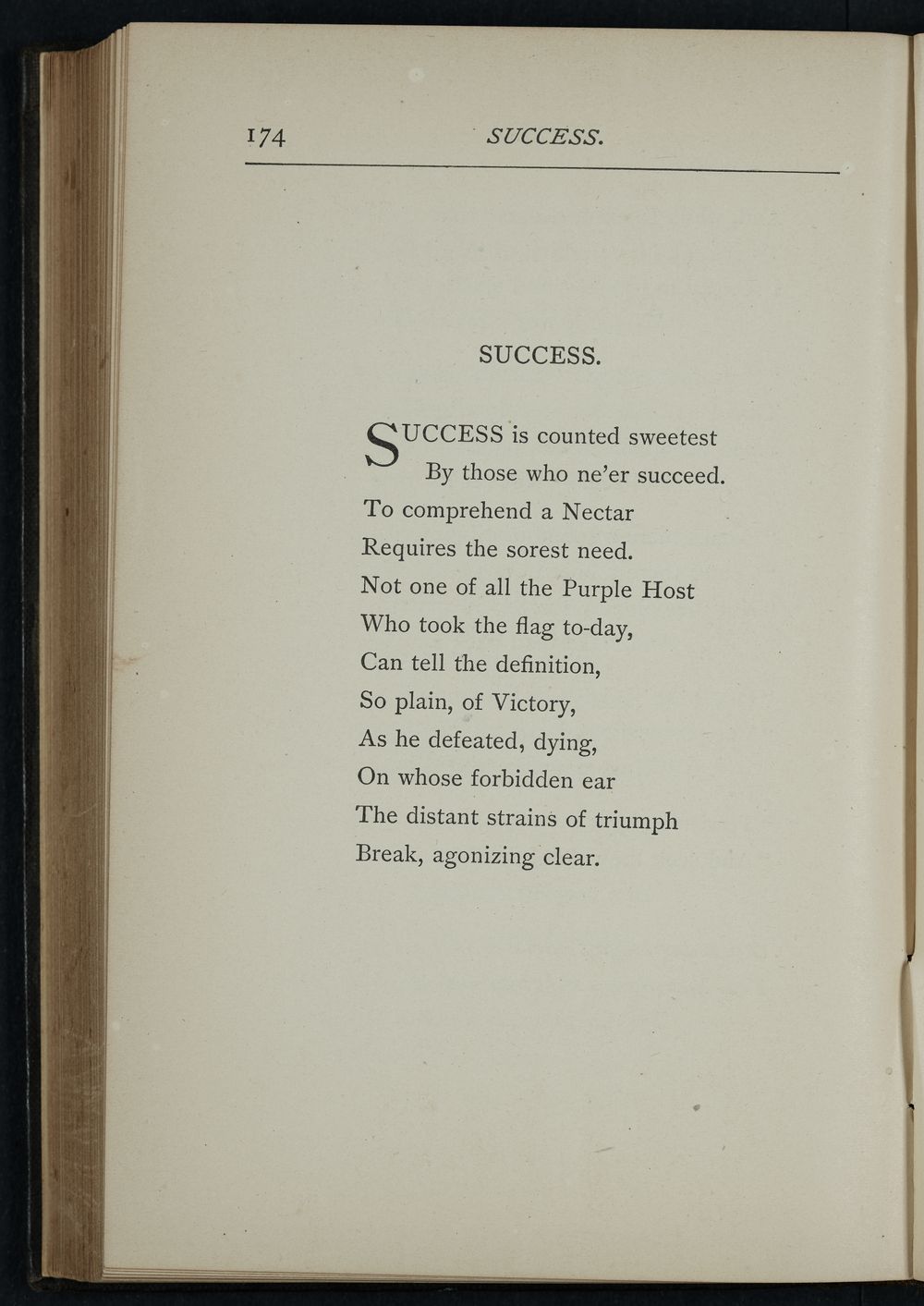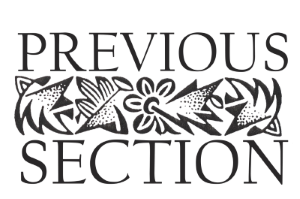POETS INTO PRINT
The three great American poets represented here played distinctive and contrasting roles in relation to their printed works. Walt Whitman (1819-1892) participated in every aspect of the production and marketing of his poetry, reshaping and repackaging Leaves of Grass through many editions. Frances Watkins Harper (1825-1911) sold her inexpensive volumes individually as she toured the country as a lecturer, converting the proceeds into activism. Emily Dickinson (1830-1886), too reticent to publish, bequeathed her poetic legacy to later editors to discover and excavate afresh.
Walt Whitman (1819–1892). Leaves of Grass. Brooklyn: [Walt Whitman (Rome Bros.)], 1855. Robert H. Taylor, Class of 1930.
First published in 1855, Leaves of Grass began as a set of twelve revolutionary poems that Whitman would continue to revise and expand radically throughout his long career. Although seven distinct American editions were published before his death in 1892, the poet was never able to surpass the groundbreaking originality of the first edition, which remains the truest manifestation of his inventive genius and democratic spirit.

Walt Whitman (1819–1892). Manuscript fragments from “A Backward Glance O’er Travel’d Roads,” [ ca. 1888]. Sylvia Beach Papers.
Framed fragments of Whitman’s working manuscripts once decorated the interior walls of Sylvia Beach’s celebrated Paris bookshop, Shakespeare and Company. According to Beach, such snippets “littered the floor” of Whitman’s home in Camden, New Jersey, and were given to her aunt, Agnes Orbison, during a visit to the poet. First published in November Boughs (1888), the exhibited text was composed on the verso of a Texas schoolboy’s 1885 fan letter.


Ralph Waldo Emerson (1803–1882). Letter to Walt Whitman. [New York: Privately printed]: 21 July 1855. Robert H. Taylor, Class of 1930.
“I am not blind to the worth of the wonderful gift of Leaves of Grass” wrote Ralph Waldo Emerson in a letter to Whitman on July 21, 1855. In turn, Whitman recognized the worth of Emerson’s praise. Although private correspondence, Whitman published the letter in full and used excerpts of Emerson’s words, “I greet you at the beginning of a remarkable career,” to advertise subsequent editions of Leaves of Grass.


Review of Leaves of Grass. Extract from Putnam’s Monthly [New York], September, 1855. Robert H. Taylor, Class of 1930.
In contrast to Emerson’s strong endorsement, many reviews of the first edition of Leaves of Grass reflected an inability to see beyond the unorthodox style of the poetry, an originality that led the reviewer for Putnam’s Monthly to describe Whitman’s greatest work as “a curious and lawless collection of poems.”

Walt Whitman’s Books: Leaves of Grass ... Democratic Vistas [etc.]. Broadside. [n.p., 1872?].
As a former printer and newspaper editor in New York, Whitman was heavily involved in the design, production, and marketing of his books. He is believed to have designed the gold-tooled floral cover of the 1855 first edition of Leaves of Grass, and he almost certainly had a hand in the typographic layout (using nine different fonts) of this 1870s broadside “show bill” advertising four of his works.

Frances Ellen Watkins [Harper] (1825–1911). Poems on Miscellaneous Subjects. Preface by William Lloyd Garrison. Boston: J. B. Yerrinton & Son, 1854.
Widely acclaimed for her achievements as a poet, novelist, orator, abolitionist, and suffragist, Frances Ellen Watkins Harper was fourteen when she began publishing poems of protest in anti-slavery newspapers. Her long-lost first volume of poetry, Forest Leaves (Baltimore, ca. 1849), survives in only two known copies. Nationwide success accompanied the publication of the exhibited Poems (1854), which included her essays on “Christianity,” “The Bible,” and “The Colored People in America.”

Frances Ellen Watkins Harper (1825–1911). Sketches of Southern Life. Philadelphia: Merrihew & Son, 1886.
Watkins Harper inscribed this anthology of poems on post-emancipation life for Caroline Griggs Crosby of Garnavillo, Iowa, adding her own signature and address: No. 10, 244 South 12th Street, Philadelphia. This was the home and headquarters of her friend William Still (1821–1902), the intrepid Underground Railroad conductor whose monumental 1872 memoir of that operation includes a lengthy chapter on the poet’s heroic work in violation of the Fugitive Slave Law.

Frances Ellen Watkins Harper (1825–1911). Iola Leroy, or, Shadows Uplifted. Philadelphia: Garrigues, 1892.
Watkins Harper actively promoted the circulation of her work. She sold this copy of her first novel, a bold vision of Black women’s roles in America’s post-Civil War communities, at the first meeting of the World’s Parliament of Religions at the 1893 World’s Columbian Exhibition. It is inscribed by its first owner: “N. Orlene Odlin, Bought from the author Francis E. W. Harper, Sept 1893 at Willard Hall, Chicago Ill.”

[Emily Dickinson (1830–1886), et al.]. A Masque of Poets, Including Guy Vernon, a Novelette in Verse. Boston: Roberts Brothers, 1878. The Howard T. Behrman Collection.
Unknown during her lifetime of solitude, Emily Dickinson emerged as one of America’s most revolutionary poets when three volumes of her poems were published in the 1890s. Dickinson’s first appearance in print was the yearning, ironic “Success,” printed in the Brooklyn Daily Union in 1864. This was also her only poem published during her lifetime (albeit without her consent) within a book, the exhibited 1878 anthology of anonymous living poets.

Emily Dickinson (1830–1886). Poems by Emily Dickinson. Edited by two of her friends, Mabel Loomis Todd and T. W. Higginson. Boston: Roberts Brothers, 1890, 1891, 1896. Robert H. Taylor, Class of 1930.
After Dickinson’s death her sister Lavinia entrusted manuscripts of nearly 1,800 unpublished poems to Mabel Loomis Todd, an Amherst writer and intimate of Dickinson’s brother, Austin. Todd heavily edited 446 poems for a three-volume series, with less intrusive assistance from Dickinson’s adviser, Thomas Wentworth Higginson. His 1890 preface explains that these poems arose “absolutely without the thought of publication, and solely by way of expression of the writer’s own mind.”

Emily Dickinson (1830–1886). “Pink, small, and punctual.” Autograph manuscript, signed. [Amherst, Mass., ca. 1875]. Robert H. Taylor, Class of 1930.
Written circa 1875 in Dickinson’s idiosyncratic penciled script, this manuscript of “Pink, small, and punctual” was presented to the poet’s sister-in-law Susan Gilbert Dickinson and passed to her daughter Martha Dickinson Bianchi, the last of the family line. The poet’s imagery may be self-referential, observing the mayflower’s humble beauty, its reticence prior to blooming at its appointed time, and its willingness not to overstay – a haunting allusion to life’s brevity.

Emily Dickinson (1830–1886). Poems by Emily Dickinson. Edited by two of her friends Mabel Loomis Todd and T. W. Higginson. Boston: Roberts Brothers, 1890. The Howard T. Behrman Collection.
“Pink, small, and punctual” was repunctuated and given the title “May-Flower” in the first edition of Dickinson’s Poems. The principal co-editor inscribed the exhibited volume “To Mrs Hills with love from Mabel Loomis Todd. Amherst, November, 1890.” This recipient was Adelaide Spencer Hills (1840–1910), another Amherst neighbor who never actually met the reclusive poet. A recipe for chocolate pudding that Dickinson wrote out for Hills survives in the Scheide Library.










